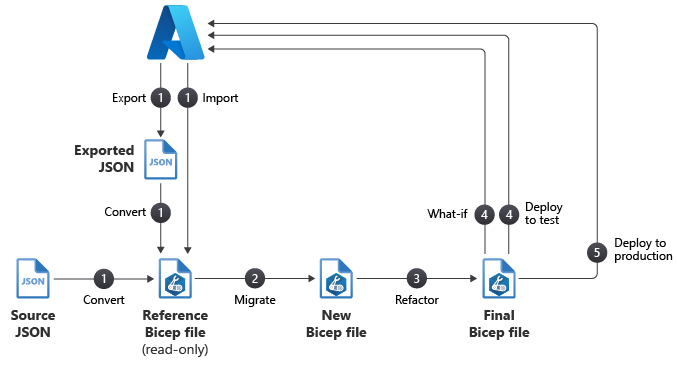Workflow to migrate your resources to Bicep
In this module, you learned about the five phases of the recommended workflow for migrating your Azure resources to Bicep. The five phases are convert, migrate, refactor, test, and deploy. This unit provides a summary of the process.

Phase 1: Convert
The goal of the convert phase of migrating your resources is to capture an initial representation of your Azure resources. The Bicep file you create in this phase isn't complete, and it's not ready to be used. However, the file gives you a starting point for your migration.
The convert phase consists of two steps:
- Capture a representation of your Azure resources.
- Convert the JSON representation to Bicep by using the
decompilecommand.
Phase 2: Migrate
The goal of the migrate phase is to create the first draft of your deployable Bicep file and to ensure that it defines all Azure resources that are in scope for the migration.
The migrate phase consists of three steps:
- Create a new empty Bicep file.
- Copy each resource from your decompiled template.
- Identify and re-create any missing resources.
Phase 3: Refactor
The main focus of the refactor phase is to improve the quality of your Bicep code. These improvements can include changes, like adding code comments, that align the template with your template standards.
The refactor phase consists of eight steps:
- Review resource API versions.
- Review the linter suggestions in your new Bicep file.
- Revise parameters, variables, and symbolic names.
- Simplify expressions.
- Review child and extension resources.
- Modularize.
- Add comments and descriptions.
- Follow Bicep best practices.
Phase 4: Test
The goal of the test phase of migrating your resources to Bicep is to verify the integrity of your migrated templates and to do a test deployment.
The test phase consists of two steps:
- Run the ARM template deployment what-if operation.
- Do a test deployment.
Phase 5: Deploy
The goal of the deploy phase of migrating your resources to Bicep is to deploy your final Bicep file to production. Before the production deployment, you need to consider a few things.
The deploy phase consists of four steps:
- Prepare a rollback plan.
- Run the what-if operation against production.
- Deploy your template manually.
- Run smoke tests.